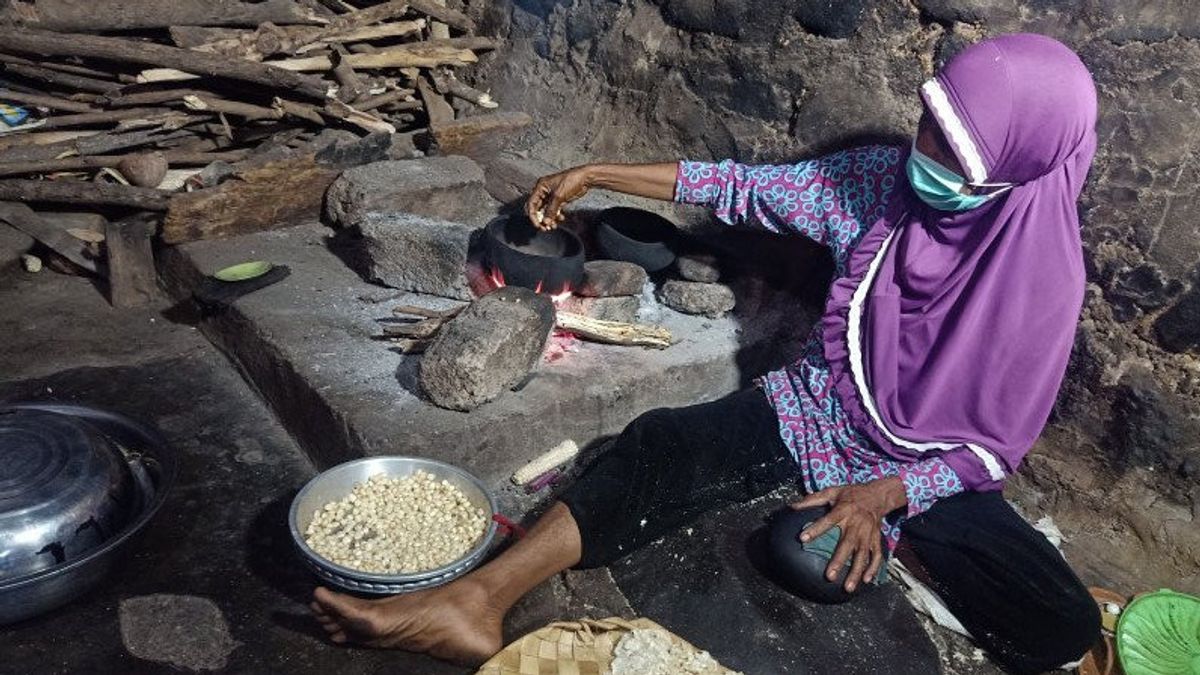East Flores - The day before Ramadan 1422 Hijri, the sound of stone collisions in Lamahala before the dawn prayer.
The sound of stone collisions comes from the east of Lawaha Traditional House, precisely in Neighbourhood Association (RT) 005, Community Association (RW) 02, Lamahala Jaya Village, Waiwerang City District, East Flores Regency.
Apparently, no less than 70 houses that occupy sloping land there are inhabited by producers of snacks typical of Adonara Island, East Nusa Tenggara (NTT) named, titi corn.
As the name implies, the food is made from corn food crops that are pounded using stones.
"Corn titi is typical food here. In this one village, we produce it. Pounded with stone until being flat, such as emping melinjo if in Java, but this material is corn," said Chairman of Neighbourhood Association (RT) 005, Community Association (RW) 02 Lamahala Jaya, Suleman Kasim (69), as quoted by Antara, Tuesday, April 13.
Corn used is a type of pulut corn. The seeds are soft and sticky textured, unlike hard hybrid corn kernels that are easily crushed when pounded.
Titi corn has been less popular in the community outside East Nusa Tenggara, because the manufacturing process is specific, only done by certain people hereditary.
The production process is done very traditionally. The seeds have been soaked overnight, then heated in a pot using firewood until half-cooked.
Uniquely, the process of stirring to remove corn kernels from a hot pot is done without the use of tools, but with the fingers of the maker. "About a handful of corn we put on a pot (stone) and pounded until it flat," said Suleman.
Zainab Abdullah (63), one of the businesses owner, is now busy pursuing the request for corn titi for Ramadan 1442 Hijri snacks. Because it has been several times that activity is delayed because attending tahlil from the families of victims of flash floods in neighboring villages.
As many as 50 corn stalks plucked from the garden, Zainab can produce up to two large basins. One basin is about 1.5 kilograms, then sold to the market or around the village.
One of his customers is H. Adnan Sangaji who currently inherits the throne of Lamahala Kingdom as the 13th descendant of the predecessor king, NN Sangaji.
"If Ramadan can add profit Rp. 15,000. If a normal day, fortunately, Rp. 30,000 a day," he said.
SEE ALSO:

King Lamahala
Encountered while saying goodbye to the King's residence near Lamahala Palace, Adnan Sangaji said a number of things related to Ramadan.
Adnan allows titi corn to be one of his favorite foods, especially during the fasting month.
"Adonara people who were traveling for a long time, he must have cried if he found corn titi there. It's food that reminds them to go home," he said.
Although the texture and process of making titi corn is similar to emping, but not with the taste. Emping is made from melinjo nut, it has a little bitter taste that can often be disguised by giving the right seasoning.
Lamahala's typical titi corn does not imply the slightest bitter taste. The sensation of taste is even more festive with the addition of salt that makes the savory taste blended harmoniously with the sweet tinge of corn.
Lamahala residents choose to keep the tradition in Ramadan, although this time it still takes place during the COVID-19 period.
"We keep the usual Ramadan tradition because the holy month only comes once every year. But of course, we are ready to follow the advice of the government to worship in accordance with health protocols," said Adnan.
Like other Muslims, Lamahala residents also make Ramadan as a moment to further strengthen the bond of friendship with each other.
"Moreover, we in Lamahala kinship is very close, all are brothers here," he said.
Therefore, the ritual of worship in Ramadan is carried out together. For example, when waiting for iftar time.
Unlike other Muslims in Indonesia who usually "ngabuburit" or waiting for the time to break their fast while looking for takjil (Ramadhan snack), Lamahala residents choose to gather at the mosque to then break their fast together.
"In our village, there is no Ramadan market like elsewhere because residents prefer to cook their own snacks or food to break the fast. But later each citizen sends food to each other, also for worshippers who wait for iftar and tarawih prayers in the mosque," he said.
In the second month of Ramadan that took place during this pandemic, Lamahala residents offered prayers to be kept away from all dangers and strengthened faith in the face of the disaster that is facing.

Clean up
Lamahala has 14 little mosques and one of the largest mosques named Jami Al Maruf. It has been the last week that the local community has been working together to clean up their places of worship.
In addition, to worship facilities, clean activities ahead of Ramadan are carried out by residents in several traditional houses as well as some tribal environments (marga).
Usually, the rest of the Islamic kingdom's historical relics in East Nusa Tenggara are used for customary events in accordance with the tribe that carried it out. One of them is a traditional government house in Lamahala village.
One of the participants of gotong royong, Dody, said that this gotong royong activity has been routinely carried out by Lamahala people every Ramadan and Eid al-Fitr.
The activity was greeted enthusiastically by residents, especially men. While women provide logistics such as food and drink.
"We hope this clean-up activity can provide mutual comfort in performing worship in the holy month. In addition, gotong royong is also a means of community friendship. Where all the people in Lamahala are all brothers," he said.
The English, Chinese, Japanese, Arabic, and French versions are automatically generated by the AI. So there may still be inaccuracies in translating, please always see Indonesian as our main language. (system supported by DigitalSiber.id)


















